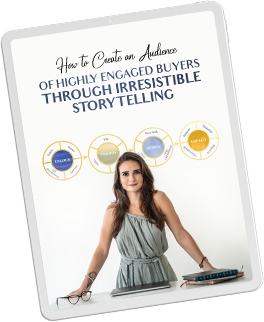Storytelling is an essential marketing tool for brands looking to ground their business strategy with messaging that is memorable, emotionally engaging, and profitable.
In my recent article, I delve into how strategic storytelling can help businesses create high-quality marketing content, strengthen brand loyalty, and improve sales conversions. The most successful brands do this by balancing emotion with just the right amount of information: a great story is easy to understand and simplifies big ideas in a way that sticks in people’s minds. Even more, it surprises, delights, makes audiences think and feel, and motivates them to act in ways that data cannot.
As Harrison Monarth, New York Times bestselling author of The Confident Speaker, stated: “A story can go where quantitative analysis is denied admission: our hearts. Data can persuade people, but it doesn’t inspire them to act; to do that, you need to wrap your vision in a story that fires the imagination and stirs the soul.”
I share key insights from my signature framework for crafting a story that connects with audiences and drives sales:
Gain Extreme Clarity In Your Vision
As a brand story coach, I frequently see business owners make the mistake of pushing out marketing content without a clear story to wrap it around. Without a story foundation, brand messaging risks being inconsistent, confusing, and sometimes even contradictory.
The first step in creating a story is to get very clear on your vision. Think of your brand as a legacy – what do you want to leave behind?
Whether you’re a sock or tech company, a powerful brand story instills a sense of bigger purpose that is beyond the product or service being offered. For example, companies like Apple, Tesla, and Facebook became some of the most admired and financially successful companies in the world by delivering financial returns while also building people and society.
When mapping out a brand vision, outline what you want to accomplish with your brand. Don’t be afraid to dream: do you want to change how the beauty industry is perceived, empower millennial women to work and travel full-time, or help entrepreneurs build six-figure businesses?
This vision should be distilled into a singular sentence, which can be broken down into three parts:
Action: What is the best action word describing what the brand is doing to serve consumers – is it empowering, teaching, coaching, providing, etc?
Target audience: Who exactly do you want to influence – are they seasoned business owners, misunderstood geniuses, fearless visionaries, innovative corporate executives? Try to capture the essence of this audience in just a couple of words.
Value: What is the transformation that is being created for the target audience through the action? In other words – what value do people get from interacting with the brand?
For example, my vision for my storytelling business is to empower passionate entrepreneurs to share stories that will bring their vision to life, create high quality and effective content, and authentically connect with the right audience.

Humanize And Relate To Your Target Audience
Paint a vivid picture of the people the brand is speaking to, and create personas if necessary. What do they like, what are their quirks, what keeps them up at night, and what lights them up? Then, take it a step further: what are the belief systems, philosophy, and lifestyle that they subscribe to and feel passionate about sharing? The idea is to uncover a tension – that is, a psychological itch that this audience needs to scratch – and then resolve that tension through the telling of a story.

GET ACCESS TO MY FREE MASTERCLASS
How to Create an Audience of Highly Engaged Buyers Through Irresistible Storytelling
For example, most of my clients are entrepreneurs with big dreams and the drive to bring them to life. Their “itches” are: they are overwhelmed with running their business, they struggle with refining and organizing their vision into a cohesive story, they don’t know where to begin or how to tell a story that ties back to ROI. My business’ brand story, therefore, focuses on addressing the challenges of being an entrepreneur, the payoffs of pursuing one’s dreams, and how it is possible to tell a story that shapes reality despite the challenges.
Address (either directly or indirectly) a tension that an audience is going through and resolve it in a way that is relatable, human, and offers a transformation. This will help your audience feel understood and connected to the brand.

Identify Core Values For Your Audience To Connect With
If the brand has a vision, it also has values. Core values are what you absolutely stand for when it comes to the brand: it’s the non-negotiable beliefs that the brand just cannot live without and that the target audience will share.
For example, my brand core values are self-discovery, human connection, and life design. I cannot fulfill my vision of empowering my clients to share a powerful brand story without helping them create an internal brand story arc, an authentic connection to the people they are serving, or content that is designed to generate results in their lives.
Identity 3-5 core values that your business was built around, and test their storytelling strength by digging into the key reasons why each value is important and how it serves the vision. For example, if the business is a fashion brand and a core value is sophistication, why is this so important? There are many ways to define sophistication – is the brand referring to price points, mindset, or style?
Core values are meant to humanize the brand by acting as conversation starters that spark thoughts, discussions, and emotional engagement in your audience. The brand should be able to speak to the core values indefinitely. These values also become the foundation for a content strategy.
It’s important to note that the vision and values are communicated inconspicuously. By consuming your content, the audience should be able to feel what the brand stands for without having it spelled out.
Create Content That Authentically Tells Your Story
Once the vision, target audience, and core values are defined, businesses can develop brand language, visuals, and communication styles to cohesively tell the brand story. Any content created – whether it be social media posts, blog, or website copy – should funnel back up to the vision and core values. Treat each piece of content as a piece of a puzzle: when everything is clicked together, the overall big picture should be apparent.
When developing a content strategy, it’s important to remember that earning brand loyalty and moving people to action goes far beyond telling a beautiful story… it’s also about authenticity. To create a story that is emotionally powerful, relatable, and gets results, don’t be afraid to reveal the heart and soul of your brand: that’s what will ultimately get people’s attention.
Originally published on Forbes

Want to become the best story
YOU'VE EVER TOLD?
Get behind-the-scenes weekly insights from me on all things storytelling,
branding, conscious life design, and other fun surprises!

